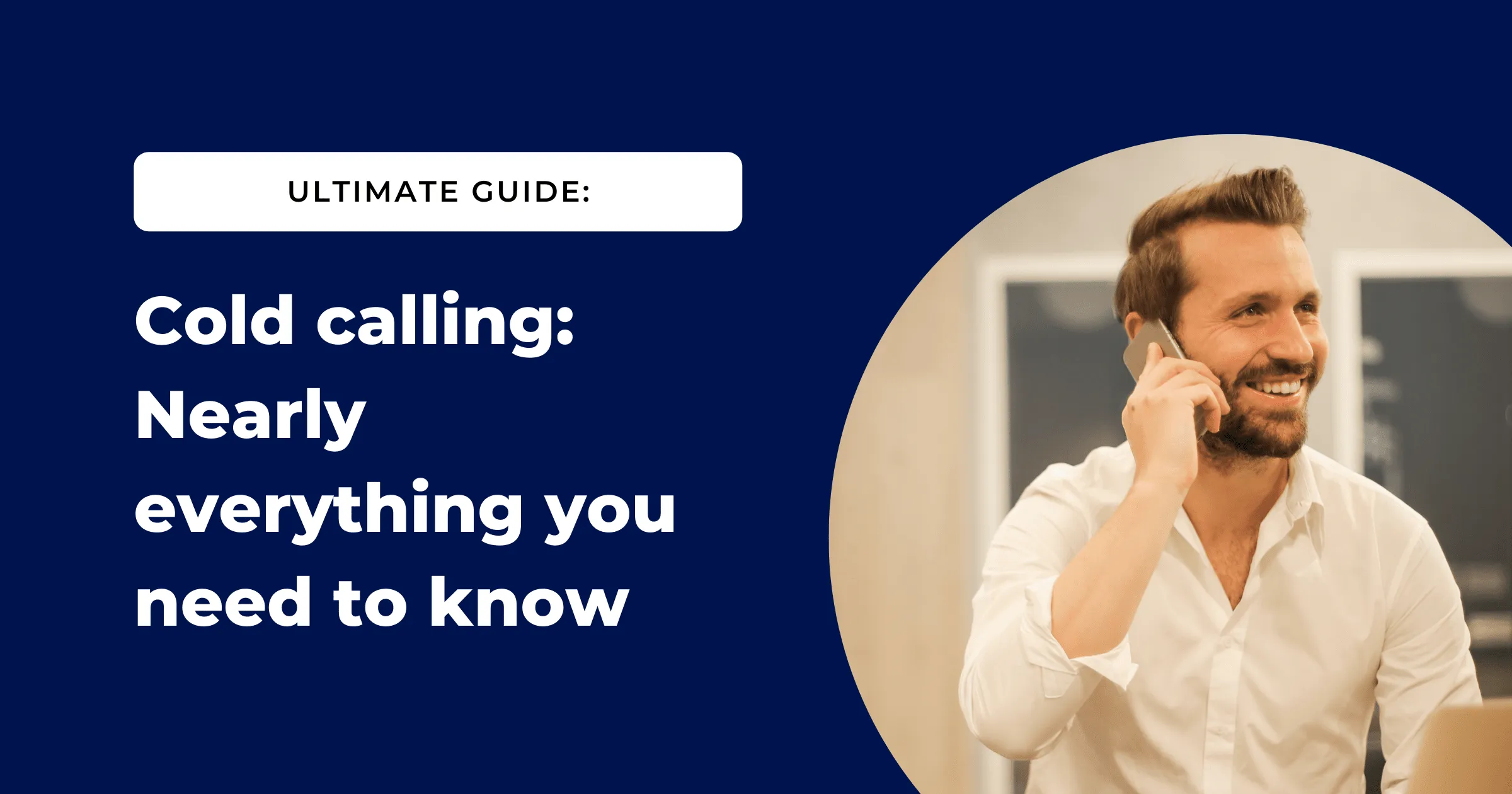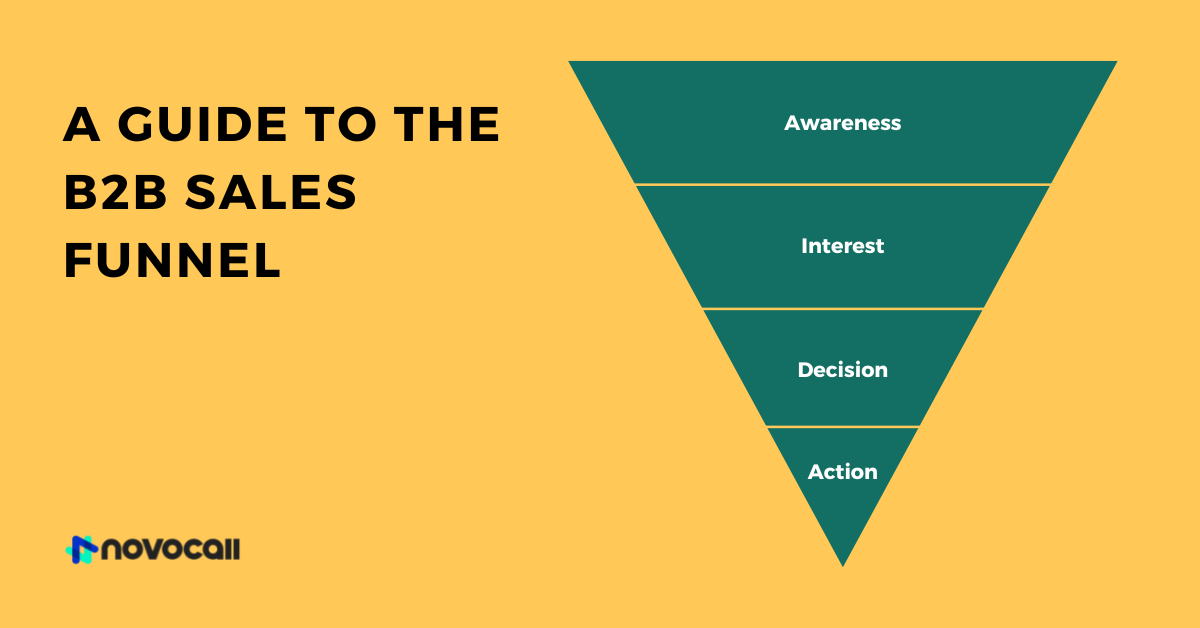


Start driving better conversations.
Novocall will be your new favorite business phone system.


In 2021, the global B2B industry was valued at $7.72 billion, and is anticipated to expand by 19.7% from 2022 to 2030.
Undoubtedly, B2B marketing will not stop anytime soon, and brands need to watch out for the latest B2B marketing strategies for the success of their businesses. Understanding and visualizing your B2B sales strategy is key to setting your business ahead of competitors.
In this article, we’ll discuss what B2B sales actually is, its benefits, 4 crucial stages in the funnel, and how you can create an effective B2B sales funnel.
Let’s get started!
A B2B sales funnel is a sequence of steps that details what B2B businesses undergo when they aim to convert prospects (business leads) into paying customers.
Its primary goal is to show businesses how prospects interact with their brands right from the first encounter and set out tangible actions to convince them to make a purchase.
The secondary goal is to increase your business’s Return on Investment (ROI).
A B2B sales funnel begins with generating leads through a series of marketing actions such as articles, automated emails, cold calls, landing pages, paid advertising, and so on. It then converts these potential customers into buyers.
At its core, the B2B sales funnel breaks down the buying process into smaller chunks, with each chunk designed to attract and convert buyers to paying customers.
The sales funnel is an essential part of every business’s marketing journey. With it, you can understand your sales process better, increase sales, and retain customers.
Here are some benefits a sales funnel will bring to your B2B business.
One significant point of a B2B sales funnel is to identify and guide your target audience through various marketing strategies and eventually convert them to customers.
To improve your B2B sales funnel conversion rate, think through the eyes of your leads, identify their problem, and then devise a solution.
While not all leads turn to customers, creating a comprehensive sales funnel will help you identify the promising leads to pursue. It narrows your focus and devotion to a specific group and helps weed out unqualified leads by guiding them through a series of steps that lead to a purchase.
For example, you can use an email survey or phone calls for new leads to understand them better.
Customers buy from businesses they trust, and not everyone will buy from you immediately. Different marketing strategies based on your audience’s interests build a buyer persona over time.
The idea is to share your content that educates, entices consistently, and builds a relationship with your would-be customers over time until they are ready to make their purchasing decision.
Have you ever felt overwhelmed with marketing activities that yield little or no results? If yes, then the B2B sales funnel will keep you focused on what to do to attract prospects and convert them to loyal customers.
It doesn’t necessarily mean making your marketing easier, but effective by using marketing tools that push customers through the sales cycle.
Not all potential customers are equal. Some require immediate attention, while others need long-term nurturing. For this reason, using a B2B sales funnel lets you sort, evaluate, and rank your leads based on customer data analytics.
Digital marketing is undoubtedly a game of numbers. And, as mentioned above, not all prospects will convert to buying customers.
However, this doesn’t mean a capture-all approach is what you need to succeed. Understanding the B2B sales funnel conversion rate helps you accurately forecast your sales volume, allowing you to manage your digital marketing effectively.
Although every business has its own distinct process of generating leads and handling customer interests, the sales funnel process follows the same steps. B2B businesses with well-executed and properly designed sales funnels follow four stages: awareness, interest, decision, and action.
To help you visualize B2B sales funnel stages, picture the shape of an inverted triangle, with the first stage starting at the top of the triangle.

From this illustration, you can see that a B2B sales funnel requires many prospects or opportunities because many leads drop off and do not make it to the final ‘action’ stage (i.e. become your paying customers).
At each stage, you should offer unique information, content, and answers to make your leads move closer to making a purchase.
Here, we’ll explain what happens in each stage and how you can optimize the B2B sales funnel to appeal to your target audience.
The first stage at the very top of the B2B sales funnel is awareness, which has the largest number of people. It’s where prospects first become aware of your service or product through word of mouth, advertising, social media, or Google search.
These people are not yet termed as prospects since they do not have much information about your brand, but they now know it exists.
According to Marketo, 96% of your website visitors are not considering buying yet but may offer their contact information.
Why and how these people move to the next stage depends on your marketing ability and sales. At this point, however, note that they probably are not thinking of buying anything, so don’t give offers.
Instead, bring attention to your brand without pushing any particular service or product.
Ensure you focus on ideas, information, or solutions to these people’s problems. The content should be informative, fun, exciting, and engaging at this stage. It needs to stand out from the competition.
Once a lead passes through the awareness stage, they evaluate it based on their interests. At this point, you’ve captured their attention and they will spend time getting to know your brand. They’ll consider their problems and conduct competitive research to ascertain if you’re offering the best products.
They may browse your website, read your blogs, or go through your past customer reviews. However, they are not prepared yet to make a purchase.
In this stage, your goal should be to familiarize them with your brand and build a lasting relationship. Offer consistent content that interests them and share it via various content channels.
As your prospects become familiar with your brand, keep in touch with them through a lead nurturing campaign such as a welcoming email followed by value-based or pitch emails.
Slowly ease them into the next phase by offering free trials, one-on-one demos, videos, or discounts to increase their interest in your product or service.
Getting prospects to make a purchasing decision isn’t an easy task. At this stage, your prospect is well acquainted with your brand, they’ve probably explored your competition, and are considering making a purchase.
Armed with information about your brand, your leads double their efforts and want to know about your pricing and packaging options.
At this point, your prospects are planning to make a purchase but want to be sure you’re the right solution for their needs. This is when and where you explain why your product or service best fits their needs.
Sale pages, calls, and tutorial webinars will help you convince your prospects to make a purchase. An excellent way to convince a prospect is to maintain an updated customer review database or take the paid ad route.
You can also include case studies, consultations, product comparisons, or discount codes.
The final stage of the B2B sales funnel is the action phase. You’ve nurtured your prospect properly, negotiated the terms of the sale, and are now ready to make an official agreement and convert your lead.
Now, convince them to buy your product through reviews, testimonials, package bundles, product training, and special offers.
If the deal is closed, your prospect now becomes a paying customer.
However, the sales process is like a cycle, it never ends. It’s important to note that the first few weeks of making that sale can break or make a potential long-term interaction with your new customer.
If you close the deal and disappear, it may turn them off, and they may fail to make any subsequent purchases. Follow up and check with them consistently if they have any concerns or questions.
Re-engaging customers might even lead them to make additional purchases and also give you referrals. Ideally, your customers shouldn’t run out of information or content about your business they can engage with.
You can decide to introduce new features, products, or even encourage your customers to become your brand ambassadors. In the end, it becomes a win-win situation.
A well-designed sales funnel can help you track your prospects as they move closer to becoming your paying customers. There are different ways to create an effective sales funnel, but the general user journey remains the same. Here is a step-by-step guide to creating a B2B sales funnel.
Knowing your target audience is essential in digital marketing. Understand your customers’ wants, pain points, needs, and desires. Know what they do on your website, what they look at, and how much time they spend.
For example, if you own a B2B security business, you must understand the commercial security solutions your audience may be seeking.
Capture your customers’ attention through a well-structured B2B sales strategy. This involves organizing your marketing and sales team, choosing the proper channels, and offering valuable content.
To convert your newly found prospect into a paying customer, develop an engaging B2B sales strategy and stay in touch with them once or twice a week. Address their key needs and overcome objections by offering free informational emails or ebooks.
Give your best offer that the customer can’t ignore or turn down — such as a discount, free trial, or product demonstration.
Improve and optimize your B2B sales funnel and determine if they are converting as expected. The goal is to get them to click the Call to Action button.
If you’re wondering what an effective B2B sales funnel looks like, let’s look at the some examples you can use for your business.
As the name suggests, the OptinMonster uses opt-in forms in a bid to turn your visitors and readers into subscribers. It integrates with platforms like Hubspot, Shopify, and Salesforce. Its premium intent exit feature will detect when your visitor is about to leave your site and then pop up the opt-in window.

With its Customer Relationship Management (CRM) platform, Hubspot’s sales funnel helps businesses track and nurture leads effectively. You can automatically track your customer’s interactions via emails, live chats, phone calls, or social media.

A well-structured sales funnel is a crucial element for every business. While every B2B consumer journey seems complicated, navigating it with the right B2B sales funnel strategy is easier.
For years, businesses have successfully used the B2B sales funnel to grow their businesses, and so can you. If you haven’t created your sales funnel, start making one now!

Shweta is a growth marketing specialist who is working with 2xSaS. She creates content that converts website visitors into paying customers for SaaS companies. In her free time, she likes driving around the city & hanging out with her friends.
Related articles
Subscribe to our blog
Get insights & actionable advice read by thousands of professionals every week.

